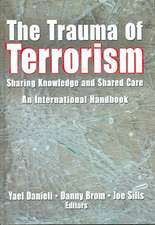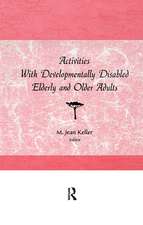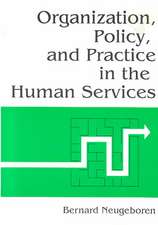Environmental Practice in the Human Services: Integration of Micro and Macro Roles, Skills, and Contexts
Autor Bernard Neugeborenen Limba Engleză Paperback – 10 mai 1996
The “ecological” perspective in social work has fostered an interest in the impact of social environments on service consumers. Environmental Practice in the Human Services tries to rectify the historical imbalance in the human services that has emphasized people-changing methods, giving secondary emphasis to environmental change. It instructs students preparing for practice in the human services, as well as agency practitioners, in the knowledge and skills necessary in environmental practice. Cases in environmental practice are used to illustrate how these skills are utilized in actual practice situations.
The book’s scope includes practice at the direct service, adminstration, planning, and social policy levels; it integrates micro and macro practice and shows how these two levels of practice are interdependent. This enables human service practitioners to create and/or modify social environments to enhance the functioning of clients being served in human service programs. Topics covered include:
- important skills in environmental practice, including decisionmaking, negotiating, and leadership
- community practice and resource coordination
- social support
- the impact of organizational environments on practice
- environmental practice for the chronically disabled
Author Neugeboren’s approach is unique in its in-depth focus on environmental practice, applying concepts of social environment to specific practice roles. This practice-specific content, which provides tools needed for environmental practice, is in contrast to existing texts on the social environment which are very theoretical and not integrated with practice. He includes material from the field of social ecology which has not been included in existing texts. It shows how practitioners and administrators, planners, and policymakers can facilitate and support each other’s work.
Reading Environmental Practice in the Human Services will enlighten students and practitioners with specific skills for impacting on different social environments to enhance client benefit. It tells how a direct service practitioner can determine which organizational environments are suitable for particular client needs in making agency referrals. It also provides administrators with information about designing, planning, and managing agencies with functional organizational environments which achieve effective services.
Preț: 393.09 lei
Preț vechi: 564.18 lei
-30% Nou
Puncte Express: 590
Preț estimativ în valută:
75.22€ • 78.73$ • 62.60£
75.22€ • 78.73$ • 62.60£
Carte tipărită la comandă
Livrare economică 31 martie-14 aprilie
Preluare comenzi: 021 569.72.76
Specificații
ISBN-13: 9780789060259
ISBN-10: 0789060256
Pagini: 408
Dimensiuni: 148 x 210 x 26 mm
Greutate: 0.75 kg
Ediția:1
Editura: Taylor & Francis
Colecția Routledge
Locul publicării:Oxford, United Kingdom
ISBN-10: 0789060256
Pagini: 408
Dimensiuni: 148 x 210 x 26 mm
Greutate: 0.75 kg
Ediția:1
Editura: Taylor & Francis
Colecția Routledge
Locul publicării:Oxford, United Kingdom
Cuprins
Contents Preface
- Part I: Introduction and Framework for Environmental Practice
- Environmental Practice in the Human Services
- Framework for a Technology on Environmental Practice
- Part II: Environmental Practice in Action
- Skills in Environmental Practice
- Community Resource Coordination on the Micro Level
- Community Resource Coordination on the Macro Level
- Social Support on the Micro Level
- Social Support on the Macro Level
- Organizational Environments
- Environmental Practice With Highly Vulnerable Populations
- Implications
- References
- Appendix
- Index
Descriere
Environmental Practice in the Human Services points to the need for the human services to return to their historic mission of environmental change. It moves beyond the more general conceptual emphasis on person-in-environment in current literature toward the development of an environmental practice technology based on an intervention model that prescribes specific micro and macro roles and functions. It may open the way to recapturing the conceptual breadth which characterized the first 40 years of social work as a professional and occupational entity.











